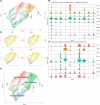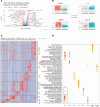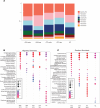Characterization of a pathogenic nonmigratory fibroblast population in systemic sclerosis skin
- PMID: 40232859
- PMCID: PMC12128984
- DOI: 10.1172/jci.insight.185618
Characterization of a pathogenic nonmigratory fibroblast population in systemic sclerosis skin
Abstract
Fibroblasts are central to pathogenesis of systemic sclerosis (SSc). However, studies of conventional explant fibroblast cultures incompletely reflect disease biology and treatment response. We isolated a second nonmigratory "resident" population of fibroblasts from skin biopsies after outgrowth of explant "migratory" cells. These nonmotile resident fibroblasts were compared with migratory cells from the same biopsy, using functional studies, bulk and single-cell RNA-seq, and localized in situ by multichannel immunofluorescence. Migratory and resident fibroblast populations in SSc showed distinct profibrotic characteristics and gene expression for pathogenic pathways differing by stage and autoantibody subgroup. TGF-β signaling was highly active in migratory fibroblasts in early-stage diffuse cutaneous SSc (dcSSc). Conversely, resident fibroblasts had less upregulated TGF-β signaling, especially in late-stage dcSSc. Increased chemokine expression was a hallmark of resident fibroblasts at all stages. In vitro studies confirmed differential response to TGF-β1 and CCL2 between migratory and resident cells. We suggest that migratory fibroblasts are especially important in early skin disease, whereas nonmigratory fibroblasts may have a regulatory role and contribute more to fibrosis in later-stage disease. Thus, we have identified a pathogenic fibroblast population in SSc, not isolated by conventional explant culture, that could play an important role in fibrosis and be targeted therapeutically.
Keywords: Autoimmune diseases; Autoimmunity; Fibrosis; Immunology; Inflammation.
Conflict of interest statement
Figures








Similar articles
-
Chemokine receptor CCR2 expression by systemic sclerosis fibroblasts: evidence for autocrine regulation of myofibroblast differentiation.Arthritis Rheum. 2005 Dec;52(12):3772-82. doi: 10.1002/art.21396. Arthritis Rheum. 2005. PMID: 16320328
-
Therapeutic interleukin-6 blockade reverses transforming growth factor-beta pathway activation in dermal fibroblasts: insights from the faSScinate clinical trial in systemic sclerosis.Ann Rheum Dis. 2018 Sep;77(9):1362-1371. doi: 10.1136/annrheumdis-2018-213031. Epub 2018 May 31. Ann Rheum Dis. 2018. PMID: 29853453 Free PMC article. Clinical Trial.
-
Talabostat, fibroblast activation protein inhibitor, attenuates inflammation and fibrosis in systemic sclerosis.Inflammopharmacology. 2024 Oct;32(5):3181-3193. doi: 10.1007/s10787-024-01536-6. Epub 2024 Aug 21. Inflammopharmacology. 2024. PMID: 39167314
-
Fibrosis and immune dysregulation in systemic sclerosis.Autoimmun Rev. 2011 Mar;10(5):276-81. doi: 10.1016/j.autrev.2010.09.016. Epub 2010 Sep 21. Autoimmun Rev. 2011. PMID: 20863906 Review.
-
Fibroblast abnormalities in the pathogenesis of systemic sclerosis.Expert Rev Clin Immunol. 2011 Jul;7(4):491-8. doi: 10.1586/eci.11.39. Expert Rev Clin Immunol. 2011. PMID: 21790292 Review.
References
MeSH terms
Substances
LinkOut - more resources
Full Text Sources
Medical

